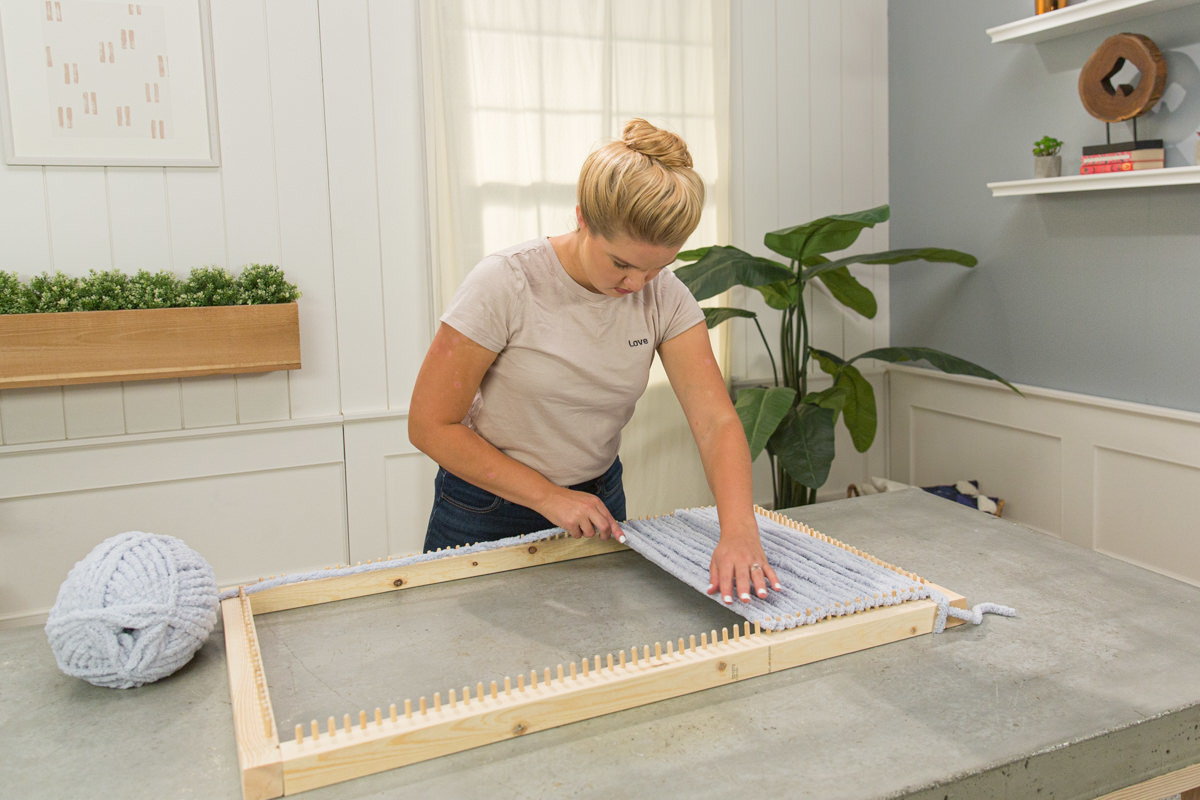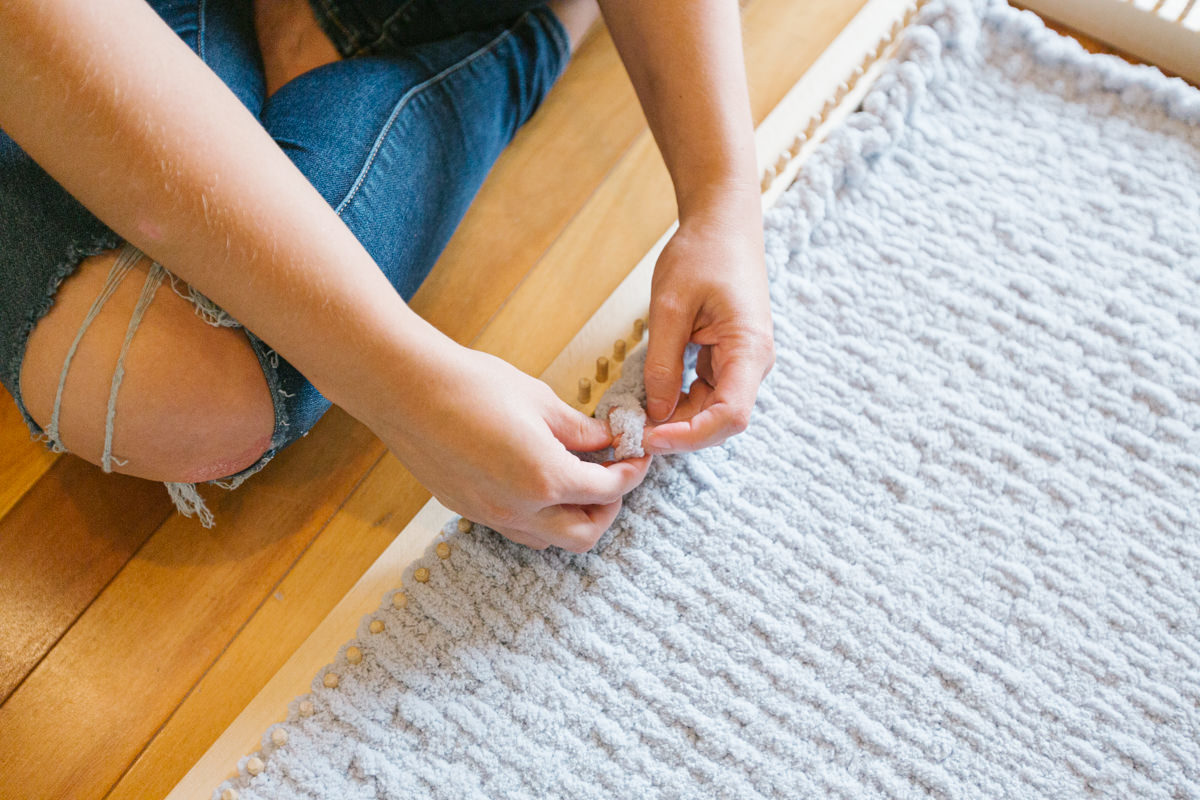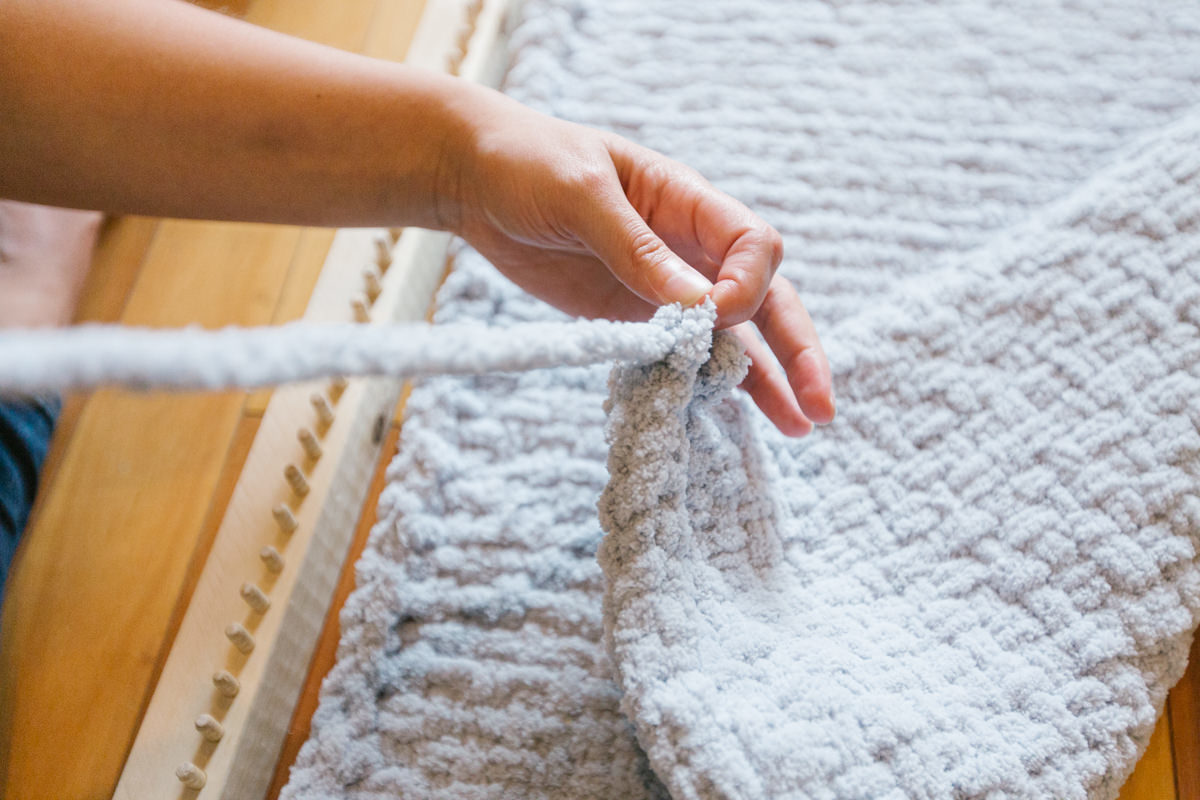
How To Build a DIY Rug Loom

"This rug loom is the perfect project to keep you or your kids busy—and it’s not only simple to build, it’s an absolute steal compared to a store-bought version."
Materials
There’s something about fall, as the changing leaves and the cooling weather drives us inside, that always sparks my creativity. As the days shorten and the indoors feel less confining and more like a cozy retreat, I find myself wanting to work with my hands and be creative. I can trace this back to when I was little and spent September afternoons creating small fall scenes for my dolls with real autumn leaves suspended in mid-air with dental floss. Although the direction of my creative expression has changed over the years, I still find myself swept up in the mood of the season and simply dripping with motivation.
With so many kids home from school, and with people in general still staying close to home, I figured this was the perfect time to lean into some cozy fall DIYs. This project is really a project within a project, because first you’ll build the loom, and then you’ll weave on it. This is the perfect project to keep you or your kids busy—and making this loom is not only simple, but is an absolute steal compared to purchasing one fully built. I always get frustrated when I want to try my hands at a new hobby but the cost of the tools needed are too steep for just “testing the waters”. But this way, you can make a rug loom for about $30 (instead of upwards of $200) and discover if weaving is up your alley before committing to a larger investment.
By design, this loom can only weave something the shape of itself. In other words, this loom is designed to weave a doormat-sized rug. If you wish to weave a scarf, a coaster, or a placemat, you can adjust the dimensions of the project. I designed this loom to work with jumbo-sized yarn or with two strands of super-bulky yarn. You could also use yarn made out of old t-shirts, but you’d have to experiment with the width to make sure it works with this loom. You can also adjust the width between the dowel pins to cater to your specific wants. If you’re going to make changes, I highly recommend making a tiny version to test it out before committing to a larger version.
I got most of my weaving strategy from CraftSanity on YouTube, so be sure to check out her videos on weaving for a visual walkthrough. Now let’s get to the project!
Step 1: Cut wood for your rug loom
First, cut the two-by-twos to length using a handsaw and a miter box. Measure the boards with a tape measure, and then clamp the wood down in the miter box to make cutting easy. Cut two lengths to 34” and two to 22 ⅝”.


Step 2: Measure holes for your rug loom
Now that the pieces are cut, it’s time to drill the holes for all of the pins. First, measure out the marks on all of your boards.
Measure down the 22 ⅝” lengths and mark 1 ½” from either end; this will be dead space where the other two-by-two lines up with the end. Measure ⅜” from the long edge, and draw a line down the length of the board. Along this line, measure first 3/4" from your 1 1/2" line at either end. Then mark every ⅝” along this line in between these two marks.
Next take the 34” length and draw a line ⅜” from the edge, down the length of the board. Mark ¾” from either end, and then measure and mark every ⅝” in between.



Step 3: Drill holes for pins
Use a ¼” spade bit to drill the holes into the frame of the loom. You can use a ¼” twist bit, but I found that the spade bit drilled a much cleaner hole, which made sanding quicker and made the finished product more polished. Mark the drill bit with tape as a guide to know when to stop drilling. You’ll want about half of the dowel pin sticking out of the frame. You don’t want the pins to sit too deep in the wood or the yarn will be more likely to slip off.
Clamp the boards down and drill through every mark with the ¼” bit. The dowel pins should be as straight as possible, so take the time to pay attention to the exact angle of your drilling to get the best results. If you're not confident in your own abilities, a second set of eyes can be a big help to keep yourself on track.




Step 4: Sand your loom
Run a fine/medium sanding sponge down the length of each side of the two-by-twos to smooth out any roughness—you don’t want your yarn to catch on anything. If you don’t have a sanding sponge, use 150-grit sandpaper.


Step 5: Assemble rug loom frame
Arrange the four sides of the loom so that the shorter sides sandwich the longer sides and all the drilled holes are along the inside of the rectangle. Pre-drill through both ends of the shorter pieces. Add glue and secure to the longer frame pieces with one 3” screw at each corner. Glue is important here because if we’re only using one screw, the pieces can twist back and forth—and that could quickly ruin your weaving.
Clamping makes this step easier. If you don’t have a long enough clamp to reach across the frame, you can clamp one of the pieces to the table so there’s less moving parts. I find this always makes things easier.





Step 6: Hammer in pegs for your loom
Now that the frame is assembled, it’s time to add the dowel pins into the holes. I found it easiest to add a row of pins at a time before hammering them snugly down into the holes. If any dowel pins are loose, or are sitting too deep in the hole, you can add glue to hold them in place exactly where you want them. After the drilling, this step goes by incredibly quickly and is extremely satisfying.



Step 7: Getting the rug started
Your loom is built, and now it’s time to weave!
Start by tying off the yarn in the upper left-hand corner. Run the yarn down and around the far-left bottom peg. Run the yarn back up around the outside of the far-left top peg. Then continue across the width of the loom, running the yarn around each peg individually.
When you circle the far-right top peg, run the yarn down to the bottom of the right-hand pegs and twist it around the peg, over to the bottom of the left hand. Then run it back above the same right-hand peg. These two strands are now your first horizontal row.
Note that the far-right vertical row only has one strand—we’ll add a second strand to it later. For now, treat it as any other row.





Step 8: Weaving the rug
To begin weaving, start by unhooking every other of the vertical rows, pulling them over the horizontal row and hooking them back in place. Now your first row is woven in. From here on out, you’ll be taking a double strand in between each peg on the right and weaving it alternately through all of the vertical rows (again, one row = two strands) before hooking it on a peg on the left. Use your fingers in between the vertical strands to push the row down to make it snug and even.
I found that the easiest way to do this was to measure out the approximate length of the double strand before weaving. Then while I was weaving it across, I would make sure that the bottom strand was taut while leaving the top strand more loose. I would push the bottom strand down with my fingers while leaving the top strand alone. Then once I reached the left side, I would pull on the top strand to make it taut and then push it down until everything was snug. Weave like this until you get to the end of the loom.
Now, remember that far-right vertical row that only has one strand? We're going to finish off the weaving by adding a second strand. Cut the yarn a little longer than the width of the loom and weave it down the right side of the loom, following the same pattern as that single strand row.
To change yarn during the weaving process (either to create a pattern or because you’ve run out), leave a short tail of the yarn you’re not using anymore hanging off the right side of the loom, and then start with the new yarn by leaving a tail in the same place. These tails will get woven in at the end.





Step 9: Finishing the rug
To finish your rug and get it off the loom, you’ll need to do a simple crochet stitch. You can do this with a large crochet hook, or simply with your fingers. Starting at the top left or bottom right (or wherever there's a tail), loop the right peg loop over the loop to the left. Loop this over the peg loop to the left, and so on and so forth until you work your way all around the loom. Don’t worry about any tails along the way. When there are no loops left, pull the tail at the end through the final loop to create a knot. Now weave all the tails into the rug. Tie a simple knot, and then cut off any excess.
And there you have it—your first rug made with your DIY loom! The best part about this project is that you can continue to use it in the rainy months to come. Experiment with different yarn, colors, and patterns to decorate your home, or make some rugs for neighbors and friends.








As the cooler months approach, it’s also a perfect time to spider-proof your home (no thank you to creepy crawlers in the house), build your own log carrier for fireplaces or bonfires, and welcome fall with this DIY banner sign.






